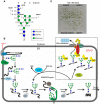Endoplasmic reticulum-associated degradation of glycoproteins in plants
- PMID: 22645596
- PMCID: PMC3355801
- DOI: 10.3389/fpls.2012.00067
Endoplasmic reticulum-associated degradation of glycoproteins in plants
Abstract
In all eukaryotes the endoplasmic reticulum (ER) has a central role in protein folding and maturation of secretory and membrane proteins. Upon translocation into the ER polypeptides are immediately subjected to folding and modifications involving the formation of disulfide bridges, assembly of subunits to multi-protein complexes, and glycosylation. During these processes incompletely folded, terminally misfolded, and unassembled proteins can accumulate which endanger the cellular homeostasis and subsequently the survival of cells and tissues. Consequently, organisms have developed a quality control system to cope with this problem and remove the unwanted protein load from the ER by a process collectively referred to as ER-associated degradation (ERAD) pathway. Recent studies in Arabidopsis have identified plant ERAD components involved in the degradation of aberrant proteins and evidence was provided for a specific role in abiotic stress tolerance. In this short review we discuss our current knowledge about this important cellular pathway.
Keywords: endoplasmic reticulum; protein degradation; protein glycosylation; protein quality control; ubiquitin–proteasome.
Figures

Similar articles
-
How Is the Fidelity of Proteins Ensured in Terms of Both Quality and Quantity at the Endoplasmic Reticulum? Mechanistic Insights into E3 Ubiquitin Ligases.Int J Mol Sci. 2021 Feb 19;22(4):2078. doi: 10.3390/ijms22042078. Int J Mol Sci. 2021. PMID: 33669844 Free PMC article. Review.
-
Endoplasmic reticulum-mediated protein quality control in Arabidopsis.Front Plant Sci. 2014 Apr 30;5:162. doi: 10.3389/fpls.2014.00162. eCollection 2014. Front Plant Sci. 2014. PMID: 24817869 Free PMC article. Review.
-
Mechanism and components of endoplasmic reticulum-associated degradation.J Biochem. 2010 Jan;147(1):19-25. doi: 10.1093/jb/mvp194. Epub 2009 Nov 18. J Biochem. 2010. PMID: 19923195 Review.
-
Unraveling the function of Arabidopsis thaliana OS9 in the endoplasmic reticulum-associated degradation of glycoproteins.Plant Mol Biol. 2012 May;79(1-2):21-33. doi: 10.1007/s11103-012-9891-4. Epub 2012 Feb 11. Plant Mol Biol. 2012. PMID: 22328055 Free PMC article.
-
The Crucial Role of Demannosylating Asparagine-Linked Glycans in ERADicating Misfolded Glycoproteins in the Endoplasmic Reticulum.Front Plant Sci. 2021 Jan 12;11:625033. doi: 10.3389/fpls.2020.625033. eCollection 2020. Front Plant Sci. 2021. PMID: 33510762 Free PMC article. Review.
Cited by
-
Cytosolic Free N-Glycans Are Retro-Transported Into the Endoplasmic Reticulum in Plant Cells.Front Plant Sci. 2021 Jan 18;11:610124. doi: 10.3389/fpls.2020.610124. eCollection 2020. Front Plant Sci. 2021. PMID: 33537045 Free PMC article.
-
Arabidopsis thaliana FLA4 functions as a glycan-stabilized soluble factor via its carboxy-proximal Fasciclin 1 domain.Plant J. 2017 Aug;91(4):613-630. doi: 10.1111/tpj.13591. Epub 2017 Jun 13. Plant J. 2017. PMID: 28482115 Free PMC article.
-
Membrane Trafficking Mechanisms and Their Biological Relevance.Arch Razi Inst. 2023 Oct 31;78(5):1397-1412. doi: 10.22092/ARI.2023.78.5.1397. eCollection 2023 Oct. Arch Razi Inst. 2023. PMID: 38590688 Free PMC article. Review.
-
N-Glycosylation of the SARS-CoV-2 Receptor Binding Domain Is Important for Functional Expression in Plants.Front Plant Sci. 2021 Jun 15;12:689104. doi: 10.3389/fpls.2021.689104. eCollection 2021. Front Plant Sci. 2021. PMID: 34211491 Free PMC article.
-
Modulation of Expression of PVYNTN RNA-Dependent RNA Polymerase (NIb) and Heat Shock Cognate Host Protein HSC70 in Susceptible and Hypersensitive Potato Cultivars.Vaccines (Basel). 2021 Oct 29;9(11):1254. doi: 10.3390/vaccines9111254. Vaccines (Basel). 2021. PMID: 34835185 Free PMC article.
References
-
- Bernasconi R., Pertel T., Luban J., Molinari M. (2008). A dual task for the Xbp1-responsive OS-9 variants in the mammalian endoplasmic reticulum: inhibiting secretion of misfolded protein conformers and enhancing their disposal. J. Biol. Chem. 283, 16446–1645410.1074/jbc.M802272200 - DOI - PMC - PubMed
Grants and funding
LinkOut - more resources
Full Text Sources

